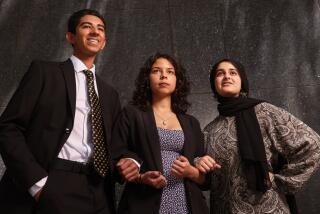Op-Ed: Parkland student activists should study the East L.A. Blowouts that launched a movement in California
High school students nationwide have vowed to ditch their classrooms on March 14 and call for gun control in the wake of the Parkland, Fla., shootings. Expect massive media coverage and rightful public praise of the protesters as brave, honorable kids doing the right thing.
Pundits will place them in the same spectrum as previous generations of young activists: the teenagers who faced down Bull Connor’s dogs and fire hoses in Birmingham, the giant college rallies against the Vietnam War, even the youth of recent years that blockaded streets to decry the anti-immigrant policies of the Trump administration.
Imagine if a lecture about the East LA Blowouts were mandatory at every California high school at the beginning of every school year.
But they’ll probably overlook the Southern California Chicano kids who walked out of school in 1968.
Thursday is the 50th anniversary of the start of the East Los Angeles Blowouts. At least 10,000 students from East L.A. high schools and beyond — shout-out to the OGs at Wilson, Roosevelt, Garfield, Belmont and Lincoln — staged two weeks of boycotts and protests against a school system they said had failed them. Openly racist teachers, outdated textbooks and a high dropout rate were just some of their complaints. Those young people helped launch the Chicano movement in Southern California and created a generation of leaders.
You rarely hear about this momentous event outside of ethnic studies classes. And that’s a shame, because it isn’t just a Chicano story, it’s a California story that deserves the same lionization as that of Mario Savio, Cesar Chavez and all the other rabble-rousers of our past who pushed the state forward. It also serves as a lesson for today’s youth on how to challenge authority.
The entirety of the Blowouts, from planning to execution to the aftermath, represented California at our intersectional finest. Those who joined the struggle knew what not enough of us acknowledge now: Though it’s important to take care of our own specific group, it’s even better when we let others help.
Just look at all the different, diverse people who played a small but crucial part in the Blowouts.
The idea came from a 1967 youth leadership retreat held at Camp Hess Kramer in Malibu, a Jewish camp administered by the Wilshire Boulevard Temple. Chicano conferences had used the site for years at the invitation of Wilshire Rabbi Alfred Wolf, who knew an oppressed minority when he saw one and understood that his privilege meant he should assist.
At the 1967 retreat was Lincoln social science teacher Sal Castro. In discussions with his students at Hess Kramer, the East L.A. native began to hash out the idea of a school boycott. Mere protests or complaints weren’t good enough, they agreed; drastic action was needed. Drawing on the long legacy of huelgas among Mexican laborers in Southern California, Castro and his young wards decided on a strike. “I didn’t know what this would mean,” he told a biographer decades later. “All I knew was that without some kind of mass protest by the students, nothing would change.”
Long before social media, Chicano youth spread the word via underground newspapers, at hipster coffeehouses and at community events hosted, as often as not, by white allies, including Episcopalian pastors. Students at white-dominant Venice High and majority-black Jefferson High walked out in solidarity with their Chicano peers. Undergrads from UCLA, Cal State Northridge and other local campuses served as mentors.
Then everyone walked alongside the East L.A. teens as they faced their destiny.
Those students didn’t just chant slogans. They presented LAUSD with a list of demands that nowadays sounds like conservative talking points: teacher accountability, better engagement with parents, better facilities. Teens attended school board meetings to make sure political promises were kept. They learned what citizens should do when elected officials don’t do their job.
And the students didn’t forget who stood by them. When the L.A. County district attorney charged Castro and others (collectively known as the East L.A. 13) on trumped-up charges of conspiracy to start the walkouts, outraged youth and their parents staged protests, held fundraisers and filed lawsuits to clear everyone’s names. When L.A. Unified fired Castro and refused to rehire him, Chicanos hectored board members until their maestro returned to campus.
Critics always point out that the walkouts didn’t permanently solve the issues Latinos still face in K-12 education. But that’s missing the point. The East L.A. Blowouts not only allowed students to demand what was rightfully theirs, it showed them that no Californian need allow the government to ignore its constituents, whether they can vote or not.
Imagine if a lecture about the East LA Blowouts were mandatory at every California high school at the beginning of every school year. Our students would learn that they can question their district officials and elected trustees, and that they can resort to boycotting classes in the face of extreme dysfunction, or perhaps extreme budget cuts. This isn’t inviting anarchy, but civic engagement, a topic that adults have historically sucked at. Better than teaching about the missions, you know?
Twitter: @gustavoArellano
Follow the Opinion section on Twitter @latimesopinion or Facebook
More to Read
A cure for the common opinion
Get thought-provoking perspectives with our weekly newsletter.
You may occasionally receive promotional content from the Los Angeles Times.











